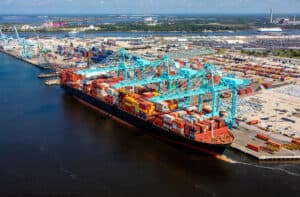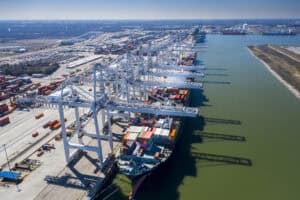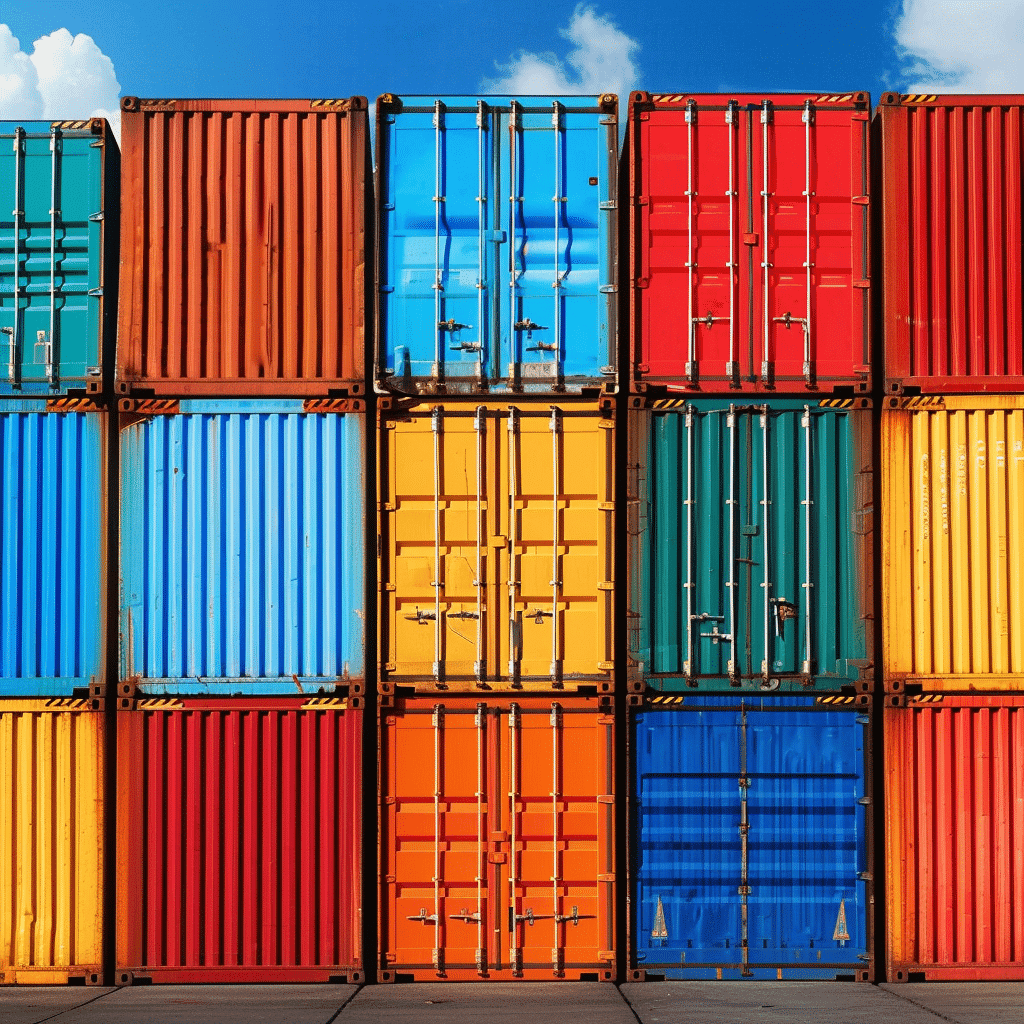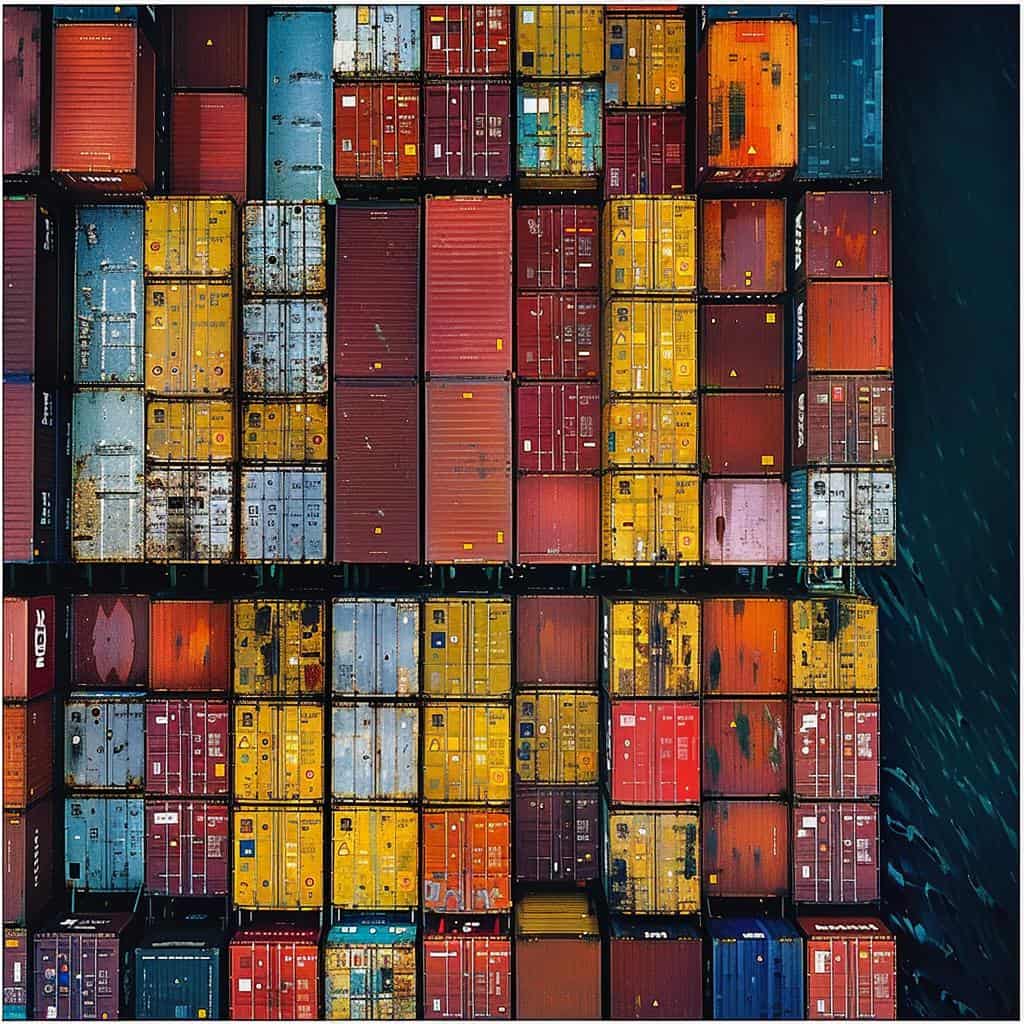Are you curious about the busiest ports in the US, right? Well, get ready to explore the top 10!
In this article, we’ll delve into the criteria used to rank these ports, like container traffic and cargo volume.
From the bustling Port of Jacksonville in Florida to the influential Port of Oakland in California, we’ll uncover the secrets behind their success.
So, sit back and get ready to discover the full list of the busiest ports in the US!
Criteria
To understand how the busiest ports in the US are ranked, you need to consider specific criteria such as container traffic and cargo volume. Container traffic refers to the number of shipping containers that pass through a port, while cargo volume refers to the total amount of goods being transported. These two factors are crucial in determining the level of activity and efficiency of a port.
The busiest ports in the US are those that handle a high volume of containers and cargo. They play a vital role in facilitating international trade and economic growth. By analyzing container traffic and cargo volume, experts can accurately rank the busiest ports in the US, providing valuable insights into the country’s maritime industry.
10. The Port of Jacksonville—Florida

Year opened: 1963
TEUs: 1.29 million
Tons of Freight: 18 million
Size: 1,500 acres
Now let’s dive into the details of The Port of Jacksonville—Florida, which handles a significant amount of container traffic and cargo volume, continuing our exploration of the busiest ports in the US.
With its strategic location on the Atlantic coast, it serves as a vital gateway for international trade.
The port handles a wide range of goods, including containers, automobiles, bulk cargo, and liquid bulk. It plays a crucial role in supporting the state’s economy and provides employment opportunities for thousands of people.
The port authorities in Jacksonville have made significant investments in infrastructure and technology to enhance efficiency and accommodate the growing demands of global trade.
With its constant growth and strategic importance, The Port of Jacksonville continues to solidify its position among the busiest ports in the US.
Cruise Industry and Cargo Operations
As one of the busiest container ports in the United States, Jacksonville plays a crucial role in cargo handling and trade. It’s the largest container port in Florida and the second largest on the East Coast. The port’s strategic location and excellent transportation infrastructure make it an ideal hub for cargo transportation.
In addition to its cargo operations, The Port of Jacksonville also boasts modern and efficient passenger terminals. These terminals cater to the cruise industry, allowing passengers to embark and disembark smoothly.
With its status as the largest port in Florida and its commitment to both cargo and cruise operations, Jacksonville continues to play a vital role in the maritime industry.
9. The Port Of Oakland—California
Year opened: 1927
TEUs: 2.33 million
Tons of Freight: 19.3 million
Size: 1,300 acres with 20 miles of waterfront
The Port of Oakland in California is another significant hub for cargo operations and trade in the United States. As one of the busiest container ports in the US, the Oakland port plays a crucial role in facilitating the movement of goods and materials.
Located on the west coast, the California port benefits from its strategic position for trans-Pacific trade. With its state-of-the-art facilities and efficient operations, the Oakland port handles massive cargo volumes, contributing to the economic growth of the region and the country.
The port serves as a vital gateway for imports and exports, connecting businesses to global markets. With its extensive network of shipping lines and transportation infrastructure, the Port of Oakland continues to play a key role in international trade and commerce.
Role in Pacific Trade and Connection to Asia
You can’t underestimate the Port of Oakland’s role in Pacific trade and its connection to Asia. Located on the West Coast of the United States, it serves as a vital gateway for trade between the United States and Asia.
With its strategic location and excellent infrastructure, the Port of Oakland has become a major hub for container terminals and trade activities. While the Los Angeles Port and the Port of Long Beach dominate in terms of sheer volume, the Port of Oakland has its own unique advantages.
Its proximity to the Silicon Valley and the San Francisco Bay Area attracts technology companies, making it an important link between the United States and Asia’s tech industries.
Additionally, the Port of Oakland offers efficient and reliable connections to the East Coast, further enhancing its significance in Pacific trade and Asia’s connectivity.
8. The Port Of Charleston—South Carolina
Year opened: 1670
TEUs: 2.79 million
Tons of Freight: 24.5 million
Size: 155 acres
Charleston, South Carolina’s Port is one of the busiest ports in the US, handling a significant amount of trade and shipping activity. Known as the Charleston Port, it plays a vital role in the economy of South Carolina and the entire country.
With its strategic location on the southeastern coast, it serves as a major gateway for international trade. The port has state-of-the-art facilities for container handling, allowing for efficient movement of goods. It consistently ranks among the busiest ports in the US in terms of container volume.
The South Carolina Ports Authority, which oversees the Charleston Port, continues to invest in infrastructure and technology to meet the growing demand and ensure smooth operations at one of the nation’s busiest ports.
Economic Impact on South Carolina and the Broader Region
With its significant trade and shipping activity, the economic impact of the Port of Charleston extends beyond South Carolina and the broader region.
As one of the busiest ports in the United States, the Port of Charleston plays a vital role in stimulating economic growth and creating jobs not only in South Carolina but also in the surrounding areas.
The South Carolina Ports Authority, which oversees the operations of the Port of Charleston, has been instrumental in attracting businesses and investment to the region, further enhancing its economic impact.
The port serves as a gateway for international trade, connecting businesses to global markets and facilitating the movement of goods and commodities.
The economic benefits generated by the Port of Charleston ripple throughout the broader region, fostering economic development and prosperity for countless communities.
7. The Northwest Seaport Alliance (Seattle and Tacoma)—Washington
Year opened: 1911 (Port of Seattle), 1918 (Port of Tacoma)
TEUs: 3.38 million
Tons of Freight: 23 million (Seattle), 21 million (Tacoma)
Size: 1,754 acres
Comprising the ports of Seattle and Tacoma, the Northwest Seaport Alliance serves as a vital gateway for trade and commerce in the region.
Located on the Pacific Coast, these ports benefit from their strategic location, offering direct access to major international markets. The Seattle port, located in the city of Seattle, handles a wide range of cargo, including containers, automobiles, and bulk commodities. Tacoma, on the other hand, specializes in handling containers, bulk commodities, and breakbulk cargo.
Together, these ports contribute significantly to the economy of Washington state, attracting businesses and generating employment opportunities. With their efficient operations and state-of-the-art facilities, the Northwest Seaport Alliance continues to cement its position as one of the busiest ports in the country.
Strategic importance on The West Coast
Located on the Pacific Coast, the Northwest Seaport Alliance’s strategic importance on the West Coast is evident in its efficient operations and state-of-the-art facilities. As one of the largest ports in the United States, it competes with other major ports such as the Long Beach Port for the title of busiest port on the West Coast.
The Northwest Seaport Alliance serves as a crucial gateway for international trade, connecting the United States with Asia and other parts of the world. Its strategic location provides easy access to major markets and transportation networks, making it an attractive choice for businesses looking to import and export goods.
With its commitment to innovation and streamlined processes, the Northwest Seaport Alliance plays a pivotal role in supporting the economic growth and prosperity of the West Coast region.
6. The Port Of Virginia—Virginia
Year opened: 1981
TEUs: 3.70 million
Tons of Freight: 61 million
Size: 7,040 acres of pier and wharf space and 4 miles of waterfront space
As we move on to discussing ‘The Port Of Virginia—Virginia’, let’s delve into its significance in the realm of international trade and its impact on the East Coast.
It competes with other major ports like the Houston Port and the Port of New York for the title of the world’s busiest port.
With its strategic location, the Virginia Port serves as a gateway for goods coming from Asia, Europe, and Latin America. Its efficient operations, state-of-the-art infrastructure, and deep channels make it an attractive choice for shipping companies.
The port’s continuous growth and expansion contribute to the economic development of Virginia and the surrounding region.
Combined Operations and Competitive Advantages
You can gain insight into the combined operations and competitive advantages of the Port of Virginia by examining its strategic location and efficient infrastructure.
Situated on the East Coast, the Port of Virginia serves as a gateway for international trade, connecting the United States with global markets. Its proximity to major metropolitan areas like Washington D.C. and New York City makes it an attractive choice for businesses looking to distribute their goods efficiently.
The port boasts state-of-the-art facilities and advanced technology, allowing for streamlined operations and faster cargo processing times.
Additionally, the Port of Virginia has established strong partnerships with other key ports such as Port Houston, Georgia Ports Authority, Jersey Port, and Long Beach, enhancing its competitive advantage by creating a comprehensive network for seamless trade expansion.
5. The Port of Houston—Texas

Year opened: 1914
TEUs: 3.97 million
Tons of Freight: 288 million
Size: 52-mile waterway
The Port of Houston in Texas, one of the busiest ports in the US, continues the discussion on combined operations and competitive advantages by offering a strategic location and efficient infrastructure for seamless trade expansion.
Situated on the Gulf Coast, the Port of Houston serves as a vital gateway for both domestic and international trade. It handles a wide range of cargo, including container ships and project cargo. With its deep-water channels and state-of-the-art facilities, the port can accommodate large vessels and efficiently process cargo, ensuring timely deliveries and reducing transportation costs.
Texas, being a major hub for industries such as energy, manufacturing, and agriculture, benefits greatly from the Port of Houston’s extensive connections and streamlined operations. This bustling port plays a crucial role in supporting the economic growth of the region and the nation as a whole.
Overview of the Port’s Strategic Location and Economic Significance
Strategically located and economically significant, the Port of Houston in Texas serves as a vital gateway for trade, handling a wide range of cargo with efficiency and precision.
The port’s strategic location along the Gulf Coast enables it to connect with major domestic and international markets, making it one of the largest and busiest ports in the United States.
With its state-of-the-art port facilities, including the Garden City Terminal and Bayport Container Terminal, the Port of Houston has become a key player in global trade.
Its efficient port logistics ensure the smooth flow of goods, while its extensive port facilities cater to the diverse needs of different industries.
As a result, the Port of Houston plays a crucial role in driving the economic growth not only of Texas but also of the entire nation.
4. The Port Of Savannah—Georgia
Year opened: 1744
TEUs: 5.89 million
Tons of Freight: 41 million
Size: 1,345 acres with approximately 18 miles of waterfront
Located in Georgia, the Port of Savannah is another bustling hub for trade and commerce, seamlessly connecting with major markets and contributing to the economic growth of both the state and the nation.
As one of the busiest ports in the United States, the Savannah Port plays a crucial role in the movement of goods and materials. Strategically positioned along the Atlantic coast, it has easy access to shipping channels, making it an ideal location for global trade.
The port handles a wide range of cargo containers, including automobiles, machinery, chemicals, and agricultural products. With its efficient operations and state-of-the-art infrastructure, the Port of Savannah continues to attract businesses and enhance Georgia’s position as a key player in international trade.
The Port’s Role in Southeastern U.S. Trade
As you delve into the topic of the Port of Savannah’s role in the Southeastern U.S. trade, it becomes evident that its strategic location and efficient operations have fostered significant economic growth in the region.
Located on the Atlantic coast of Georgia, the port serves as a vital gateway for international trade, connecting the Southeastern United States to global markets. With its deepwater channels and state-of-the-art infrastructure, the port has become one of the busiest ports in the world.
It operates multiple terminals, including the Ocean Terminal, which handles various types of cargo. Additionally, the Port of Savannah isn’t only a major hub for container shipping but also the largest passenger port in the Southeast. Its continuous growth and ability to accommodate large vessels contribute to its status as one of the world’s busiest ports.
3. The Port Of Long Beach—California
Year opened: 1911
TEUs: 9.13 million
Tons of Freight: 80 million
Size: Spanning 3,200 acres with 31 miles of waterfront
The Port of Long Beach plays a crucial role in facilitating global commerce, connecting businesses and consumers around the world. With its strategic location, it serves as a vital link in the supply chain, handling a diverse range of goods and cargo.
The port’s main container terminal, along with its deepwater terminals, enables efficient movement of goods, contributing to the smooth flow of international trade.
As one of the largest ports in the country, it competes with other major ports like the Baltimore Port in the Eastern United States, ensuring the continuous growth and success of the American economy.
Cargo Handling Capabilities and Major Trade Routes
Maximizing efficiency and global connectivity, the Port of Long Beach in California boasts impressive cargo handling capabilities and serves as a vital hub for major trade routes.
With its strategic location on the West Coast, the port facilitates trade between the United States and Asia, making it a key player in international commerce.
It handles a wide range of goods, including automobiles, electronics, and petroleum products. The port’s advanced logistics operations ensure seamless movement of cargo, while its state-of-the-art facilities and equipment enable efficient handling and storage.
Additionally, the Port of Long Beach is well-connected to other major ports along the West Coast, such as the Virginia International Gateway, creating a network of trade routes that cater to the demands of global markets.
2. The Port Of New York And New Jersey (Newark)
Year opened: 1921
TEUs: 9.49 million
Tons of Freight: 136 million
Size: 960,000 acres
The Port of New York and New Jersey, located in the states of New York and New Jersey, is one of the busiest ports in the country. It serves as a crucial gateway for international trade, handling a wide range of cargo from all over the world.
With its strategic location and excellent infrastructure, the port offers direct and indirect employment opportunities to thousands of people. It’s a vital economic engine for the region, contributing significantly to the local and national economy.
Being one of the top ports in the US, the Port of New York and New Jersey plays a pivotal role in facilitating trade and ensuring the smooth flow of goods.
Facilities and Infrastructure
When exploring the bustling Port of New York and the New Jersey port (Newark), you’ll find a well-developed infrastructure and state-of-the-art facilities.
As the primary port on the East Coast and one of the busiest ports in the United States, it’s equipped to handle a wide range of specialized cargo. The port boasts a vast network of terminals and berths, capable of accommodating large vessels. Its facilities include modern container terminals, equipped with advanced technology for efficient cargo handling and storage.
The infrastructure at the port is designed to optimize the flow of goods, with well-maintained road and rail connections that ensure seamless transportation of cargo to and from the port.
1. The Port of Los Angeles—California
Year opened: 1907
TEUs: 9.91 million
Tons of Freight: 63 million
Size: 7,500 acres of land and water along 43 miles of waterfront
The Port of Los Angeles, located in California, is one of the busiest ports in the United States. With its strategic position on the West Coast, it handles a significant amount of cargo passing through its facilities.
As one of the busiest ports in the country, the Port of Los Angeles plays a crucial role in the movement of consumer goods and other commodities. It serves as a major gateway for international trade, enabling the efficient transportation of goods to and from Asia, Europe, and other parts of the world.
The port’s extensive infrastructure and state-of-the-art facilities enable it to handle a wide range of cargo, making it a vital hub for global commerce.
Major Types of Cargo Handled
The Port of Los Angeles manages a diverse range of cargo, reflecting its status as one of the top 10 busiest ports in the United States. This role is central to facilitating trade and commerce.
The port oversees the handling of various cargo types, including bulk cargo and foreign waterborne tonnage. Bulk cargo, encompassing goods like coal, grain, and oil, is typically unpackaged and transported in large volumes. It requires specialized equipment for loading, such as cranes and conveyor belts.
Furthermore, the Port of Los Angeles deals with foreign waterborne tonnage, which is the weight of cargo transported by vessels from international waters.
Through its efficient operations and comprehensive infrastructure, the Port of Los Angeles ensures a seamless flow of goods, significantly contributing to the economic development of the region.
Frequently Asked Questions
What is the busiest port in the USA?
The Port of Los Angeles is the busiest container port in North America.
What is the fastest growing port in the United States?
The Port of Savannah is the fastest growing port in the United States.
Which is currently the busiest port in the world?
The Port of Shanghai in China is the world’s largest and busiest port in terms of container volume and traffic.
Conclusion
So there you have it, the top 10 busiest ports in the US.
From the Port of Jacksonville in Florida to the Port of Los Angeles in California, these ports play a crucial role in trade and commerce.
With their state-of-the-art facilities and infrastructure, they handle a wide range of cargo and connect the various US ports to various parts of the world.
These ports are the lifeline of our economy , keeping goods flowing and businesses thriving.


